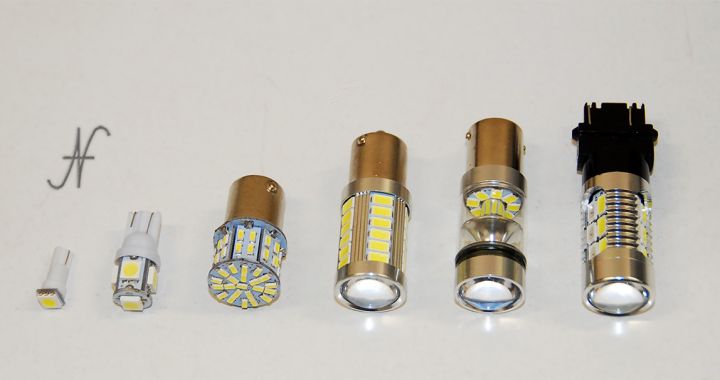It will have happened to anyone to buy LED bulbs for their car, but also for their home, and to see them broken, turned off, after a few hours of operation. In this article I will briefly analyze the causes of the breakage and suggest solutions.

But why don't LED bulbs last the promised 10000-30000 hours?
I really tried several LED bulbs and I realized that, if the bulbs do not last long, the main problem is a incorrect design of the same. It sounds strange, but that's just the way it is. It is not a question of materials, especially if we talk about low-power bulbs: position lights, LED arrows, lamps for backlighting buttons. It is really a matter of design, so much so that, going to correct, where possible, the errors, these bulbs could work forever!
For those who have time and desire to study a datasheet (technical sheet) of an LED, you can follow this link. It is just one example of a high-brightness white LED, taken at random among those that can also be used in LED lamps for position lights, reverse and also for the backlight of the dashboards.
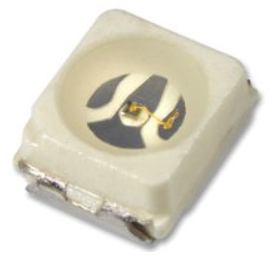
Operating parameters of the LEDs
The parameters to be taken into account are as follows:

- Forward voltage (VF): indicates the voltage that develops at the ends of the LED when it is crossed by current. In the datasheet you can see that it is between 3.7V and 4.2V.
- Forward current (IF): the current that the LED must travel to turn it on. The datasheet suggests a current of 20mA, which must never exceed 30mA.
- Junction temperature (Tj): the maximum internal operating temperature (maximum junction temperature), which must never be higher than +110°C in our example LED.
- Thermal resistance Junction/Ambient (Rthja): the dissipation factor, how many degrees increases the junction temperature with respect to the surrounding environment for each Watt of power absorbed (and therefore dissipated). In our example LED, 400K/W = 400°C/W.
Now, if I had to advise the designer of an LED lamp how to design it, I would definitely start from the data listed above (obviously after defining that the type of LED taken into consideration is suitable for the application in terms of color and brightness).
Calculation of thermal dissipation
So, having determined that our sample LED can be fine, we must adjust the current so that the heat dissipation is correct.
If traveled by the recommended current of 20mA (= 0.02A), our LED will have a voltage drop of about 3.7V.
Therefore the power dissipated is:
Watts = Volts * Amps = 3.7 * 0.02 = 0.074W
At this power, the temperature of the led junction (the internal temperature of the led) will increase by:
T = Watt * Rthja = 0.074 * 400 = 29.6°C
What did we discover? That if we use the values suggested by the manufacturer of the LED, the latter will increase its internal temperature by almost 30 ° C compared to the temperature of its environment (the dashboard box, or the inside of the car headlight), provided that the mounting technique suggested in the datasheet is used.

Since the maximum junction temperature (Tj) is 110°C, this means that our LED will never have to work inside a headlight or dashboard when the temperature of the latter is above 80 ° C, which for our application is perfect.
Unfortunately, designers may decide to increase the operating current of the LED (IF), in order to make it brighter. Or they could choose a less performing LED and increase the operating current (IF) in addition to the maximum value, making the LED heat up disproportionately and reducing its life in a sensitive way.
Or they may choose a current regulator that is too delicate. The current regulator is used to impose the operating current (IF) on the LED, but, if the regulator is poorly designed (even for the components of the regulator there are datasheets and calculations must be made!), it could be damaged before the LED itself. In case the current regulator is damaged, the LED bulb would no longer work despite having correctly designed the heat dissipation of the LEDs with the above formulas.
Other design errors
Normally LED bulbs consist of multiple LEDs. The way of connecting them also affects the life of the lamp.

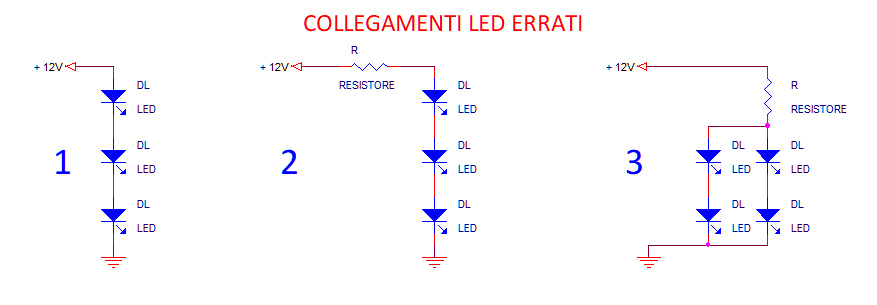
In the diagrams above we can find some connections that I have personally verified in some LED bulbs.
LED design error #1
Nell’Example 1, who designed the LED lamp, believed that the LEDs were light bulbs and connected them in series without a current regulator (without resistor).
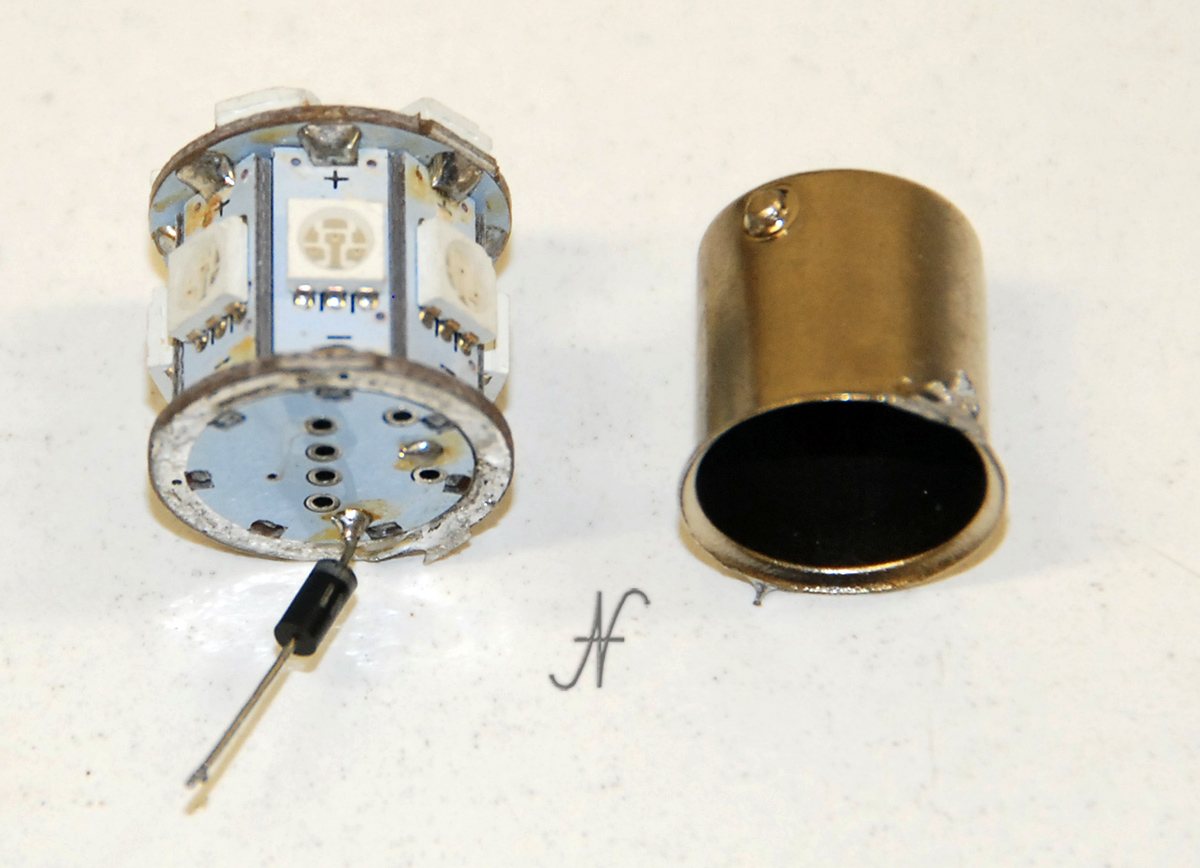
I personally found the bulb (photographed above) absolutely dim, with no resistors to regulate the LED current. The lamp was excessively hot and would not have lasted more than an hour. Unfortunately, even by adding the appropriate resistors, the lamp was too dim to be mounted on my car. I will eventually be able to use it in a nativity scene...
LED design error #2
Nell’Example 2, everything would seem correct: the LEDs are connected in series with a resistor that regulates the operating current (IF). Too bad that such a configuration works only on paper and not in real life! I personally purchased motorcycle knob cover lights that lasted less than a season. They had the problem drawn in Example #2. After finding it, I solved it by reconnecting the LEDs as I will indicate in the following paragraphs.
Let's see why the configuration of example #2 is incorrect. If we connect three LEDs in series, we have an estimated operating voltage of 3 times the fall of the single LED.
The voltage at the ends of the three LEDs is:
Vled = 3 * VF = 3 * 3.7 = 11.1V
Well, if the battery voltage (Vbatt) is 12V, our "good" designer of low cost LED lamps will calculate the resistance (R) regulating the operating current (IF) in this way, according to Ohm's first law :
R = (Vbatt – Vled) / IF = (12 – 11,1) / 0,02 = 45ohm
It will then find a resistor with a value similar to that of calculation, but that is actually existing on the market: 47ohm.
Too bad that, when the engine of our car or motorcycle is turned on, the voltage at the ends of the battery can exceed 14V! Making simple calculations, always using Ohm's first law:
IF = (Vbatt – Vled) / R = (14 – 11,1) / 47 = 0,062A
The IF current is now 62mA, capable of destroying the LED as it is too high, because it is higher than the maximum IF.
Even assuming we calculate the resistance value (R) for a voltage of 14V and not 12V (and therefore about 145ohm), we would have another problem: the brightness of the motor-off LED would be too low, as the IF current would be about 6mA, well below the 20mA we need.
The only solution is do not put three LEDs in series (if these have a high VF voltage like the one in our practical example), but put the LEDs in series two by two!
LED design error #3
Finally we have theexample number 3. This configuration is, unfortunately, very common among LED bulbs that you buy cheaply. We cannot exclude that the LEDs, although connected as in example No. 3, work. However, there is a problem of balancing the IF operating currents.
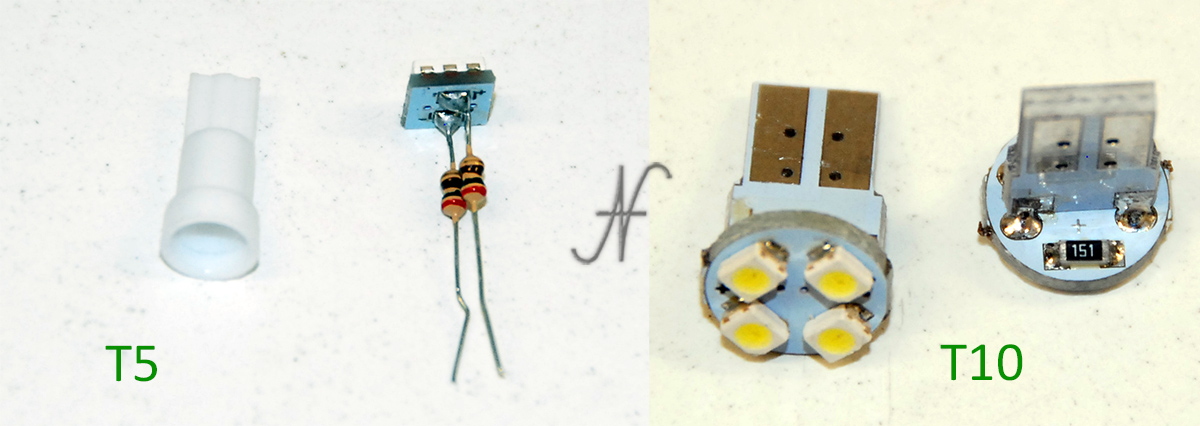
We must then calculate the resistor (R) so that the current generated is double the operating current of the single series of LEDs, as there are two series. Leaving aside the accounts (already seen in the previous example), we should use a 150ohm resistor (R), which ensures a total current of 40mA between the two series of two LEDs. Each series should absorb 20mA. This is quite true, but not quite. If we are going to analyze carefully the datasheet of our example LED, we note that there is a relationship between VF (LED operating voltage) and IF (LED operating current). We find it in the graph of Fig. 4 on page 3. In short, we note that even a difference of 0.1V, of operating voltage tolerance (VF) between one LED and another, can cause different absorptions (IF) even of different mA.
This means that some LEDs may absorb a few mA more and others less. In the event that the IF current of an LED exceeds the maximum allowable, or with that extra current heats up in addition to the permissible junction temperature (Tj), the LED may be damaged. If the LED is designed well, with all the accounts listed above, most likely an imbalance of currents would not cause any damage. On the contrary, if the designer has calculated an IF current very close (or even higher) to the maximum allowed, even a small imbalance could cause the LED to heat up disproportionately and damage it.
Correct design of LED bulbs
After seeing what not to do to design an LED lamp, let's now see some examples of a well-designed light bulb. Taking advantage of the techniques and schemes that I will provide, it will also be possible to correct poorly designed bulbs, or take advantage of the LEDs of non-working bulbs to make other, better lamps.

Remember that the LEDs must be driven in current (the IF current previously described) and not in voltage. The VF voltage will develop when the LED is crossed by the IF current. For low power lamps, the IF operating current, of a few tens of mA, can be conveniently generated by a resistor (indicated with R in theExample 2 of the correct schemes above).

Also from example no. 2, it is clear that the maximum number of LEDs that I recommend connecting in series under a single resistance is two. This applies to white LEDs with high brightness, not excluding that there are different LEDs, which have lower operating voltages (VF) and therefore allow them to be connected even in series of three or four (for 12V power supplies).
If you have the datasheets of the LEDs to use, I recommend retracing the calculations at the beginning of this article.
If the technical data of the LED is not available?
If, on the other hand, the technical data of the LED are not available, in a prudential way I would not travel more than 15-20mA on the series of the two LEDs (and in any case on the single LED, since the current that runs through the series of the two LEDs is equal to the current that runs through each LED of the series). I therefore recommend starting with a resistor (R) of 470ohm (1/4W of power) for the series of two LEDs. In the case of a single LED, I recommend starting with a 560ohm (1/4W) resistor. The values of the resistors are already calculated assuming a supply voltage of 14V and a voltage drop of about 3V LED.
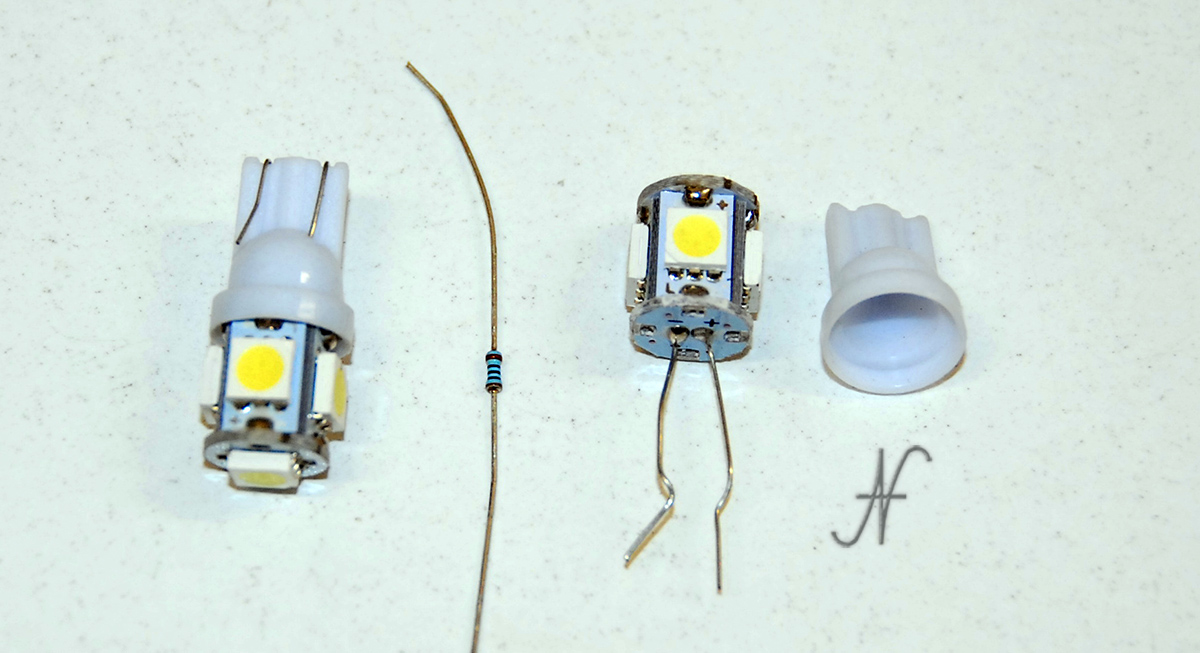
When the first provisional assembly is carried out, it is possible to measure the actual current that runs through the LEDs by means of a tester. After the measurement, it will be possible to decide to increase the value of the resistors to reduce the absorption, or to reduce the value of the resistors to increase the absorption of the LEDs.
During the test, you need to be sure that the LEDs do not dissipate too much heat: paying attention not to get burned, it must be possible to hold a finger on the LEDs, feeling only a feeling of lukewarm. LEDs do not have to be absolutely hot.
To make lamps of more than two LEDs, it will be necessary to make several series of two LEDs, with the respective resistors (R) all the same, then connecting them in parallel as in theExample 3.
Polarity of LED bulbs
Finally, for completeness of information, remember that LEDs work in one direction only, correctly connecting the + and - poles. In case of polarity reversal, the bulbs do not turn on.

Is it possible to damage LED bulbs by connecting them in reverse?
If I said no, I would be lying. Carefully reading the datasheet of the LED taken as an example, we find another parameter that many overlook: the maximum reverse voltage, reverse voltage (VR). This is the maximum voltage that the LED can withstand when connected with the inverted poles. We can note that, in our example LED, the maximum reverse voltage VR = 5V. Therefore it is actually possible to burn an LED by reversing the polarity, because we could apply higher inverse voltages to it.
This parameter is to be taken into account if we want to mount LED lamps in special conditions, when it is possible that the polarity of the lamp can be reversed in the circuit (for example on the charging light bulb of the alternator of some vintage cars). In this case, you have to install a diode (D), type 1N4007, inside the LED lamp, after the resistor (R), as in example no. 4 of the previous image. The diode will protect the LED from reverse voltages: when connected with inverted polarity, the lamp will not turn on, but it will not be damaged.
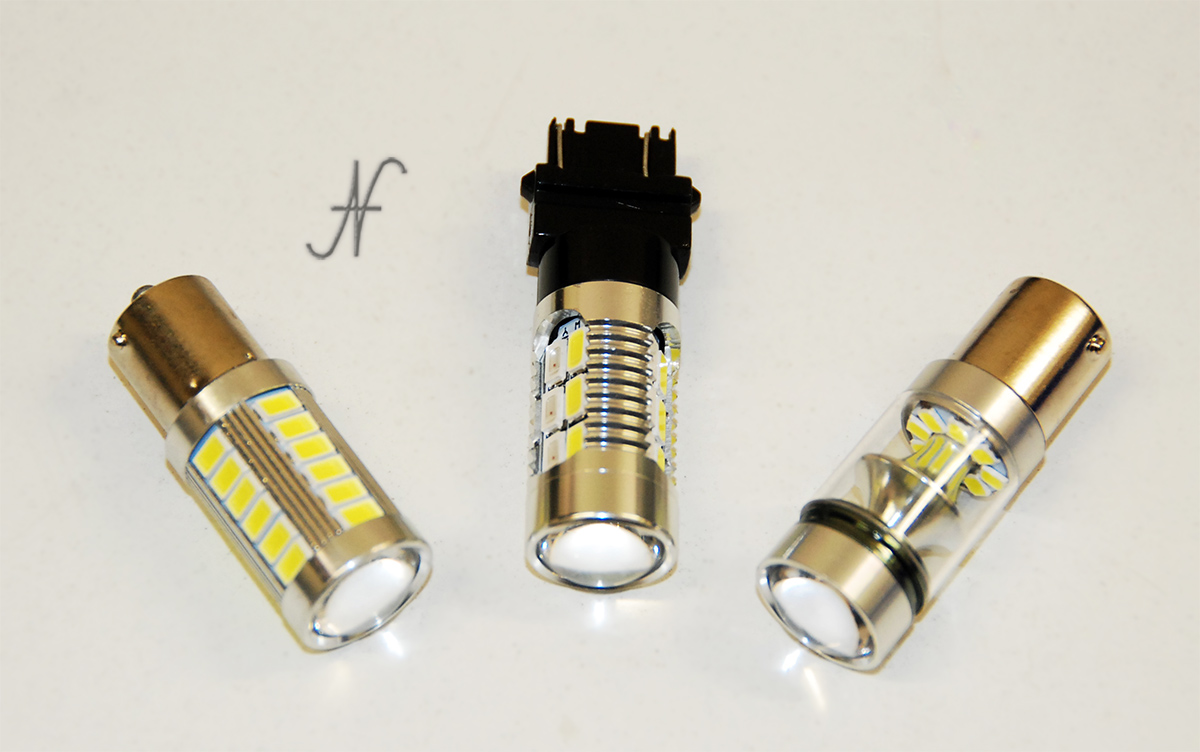
To protect the LED against reverse polarity, solutions with diode outside the LED are possible. What if we wanted to make a lamp that turns on even with inverted polarity? Or with alternating current? For the answers you will have to wait for the next articles!
In the next articles, I will also indicate solutions for avoid flickering of the LEDs in case of PWM power supplies (present in modern cars).
Per avoid the error of the control unit (which some call canbus error), which could indicate that the lamp is damaged, if it is replaced with an LED bulb, I wrote this article.
